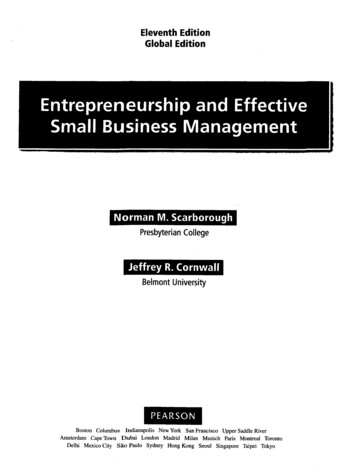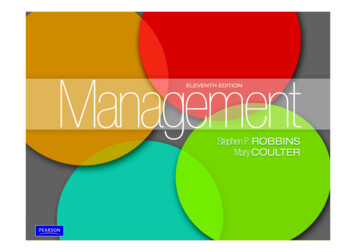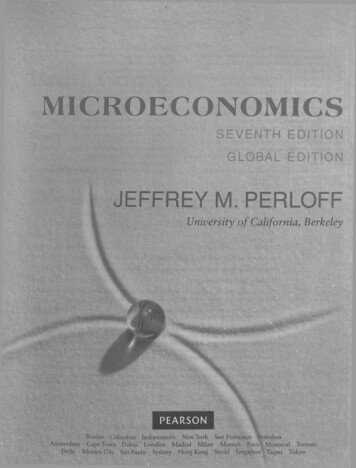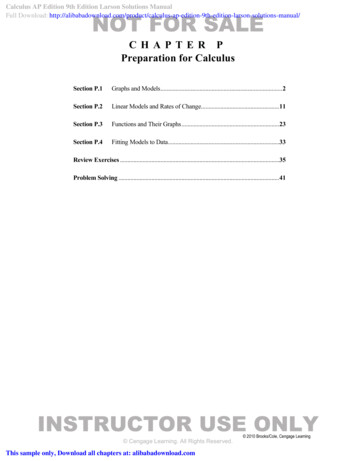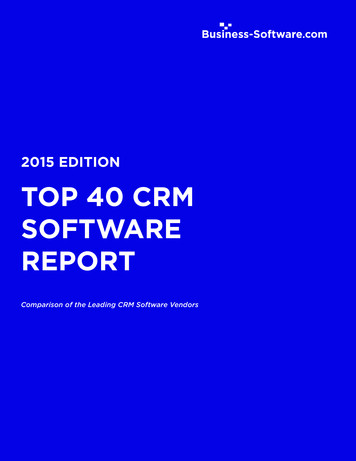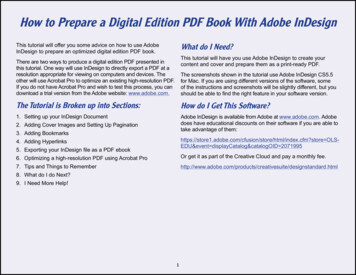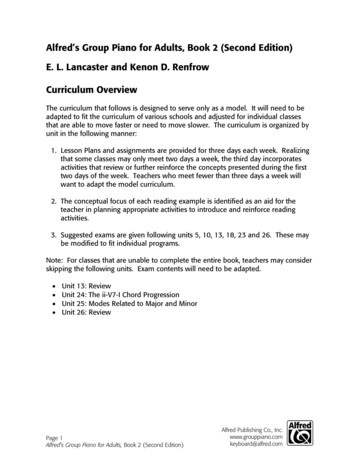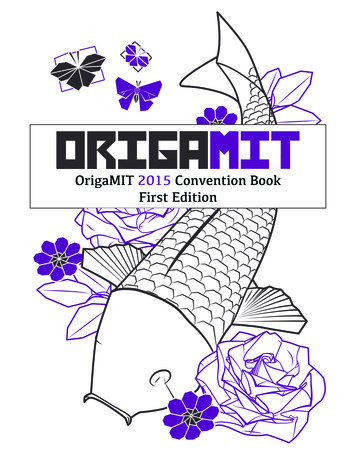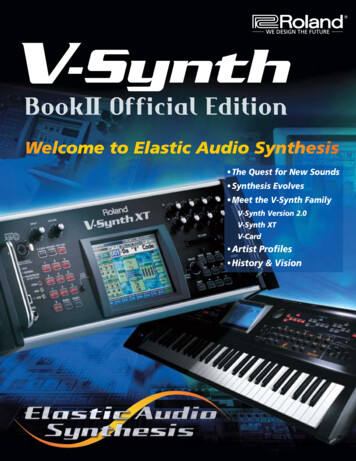
Transcription
BookII Official Edition The Quest for New Sounds Synthesis Evolves Meet the V-Synth FamilyV-Synth Version 2.0V-Synth XTV-Card Artist Profiles History & Vision
* These pictures ware taken at a Roland event in spring 2005.2*Photo by Richard Salvador, Eiji Kikuchi3
Welcome to Elastic Audio SynthesisTAhe Roland V-Synth and V-Synth XT are uniqueand expressive instruments designed to givet Roland, we believe real synthesis meansmanipulating audio elastically. But what exactlyplayers total control over their sound. With a powerfuldoes that mean? Think of a rubber bandmultiplex synthesis engine that combines sophisticatedand how it can be stretched into any shape or form.modeling with realtime audio manipulation, Roland’sNow imagine being able to apply the same principlesV-Synth instruments let you discover the “sound withinto any sound—giving you the flexibility to stretchthe sound” using an intuitive programming interfaceand re-shape it all from a single waveform or sample!and a myriad of realtime controllers. We call this “elasticThe V-Synth and V-Synth XT have this power, thanksaudio synthesis,” and it’s what separates the V-Synthto Roland’s proprietary VariPhrase technology,family from all other synthesizers on the market.which enables realtime and independent manipulationWhy limit yourself to traditional types of synthesis likeof a sound’s pitch, time and formant. So, for example,analog modeling, FM or sampling, when you can havea traditionally short sound like the attack of a pianoinfinite possibilities and unparalleled sonic control?key can be re-shaped and stretched into a long evolvingsound. Or you could re-pitch a vocal performance in realtime—even polyphonically—while keeping the soundcompletely natural.Elastic audio synthesis gives you the power to makeany sound work the way you want it to—liveor in the studio. This book will help familiarize youwith the V-Synth family and give you some helpful tipsto get the most out of them. Happy programmingwith the V-Synth and V-Synth XT!Contents6The Quest for New Sounds12Synthesis Evolves16Meet the V-Synth Family28Richard Barbieri4V-Synth Book II Official Edition18V-Synth Version 2.030BT22Tatsuya NishiwakiV-CardV-Synth XT322638History & VisionWelcome to Elastic Audio Synthesis5
The Quest for New Soundsby Paul NagleSynthesis: the combining of often diverse concepts into a coherent whole or system.For too long now, we have allowed ourselves to believe that a synthesizer is merely a keyboard-orientedinstrument whose sole purpose is to mimic pianos, saxophones, brass and so on. Even in terms of purely electronicsounds, our minds seem preconditioned. For example, mention “Moog” and the vast majority instantly think of fatbasses and solos. But it wasn’t always this way. Many years ago, musicians in the know would never have thoughta synthesizer’s role was to reproduce already familiar sounds. Instead, they would have whispered in hushed tonesabout creating original noises previously unheard by anyone; of developing innovative performance techniques neverbefore witnessed and they would have spoken of the vast potential that lay ahead for these electronic wonders.It’s all too easy to blame the advent of digital technology for the demise of such dreams. Simple analogue waveformssurely can’t represent the end of the story, can they? When musicians were given hundreds of realistic soundsand the potential to use real-world recordings as the raw material for synthesis, the future should have beenmore exciting than ever! And, indeed, some instruments came along that did represent very real steps forward.Time has passed and we have seen spurtsof innovation here and there. VirtualAnalogue synthesizers gained popularity, offeringDSP models of the oscillators and filters we knewalready, plus internal effects and far greaterpolyphony than their analogue counterparts.However Virtual Analogues came in veryconventional packages, mostly recycling what wasalready familiar; they didn't aim to establish freshsonic palettes and broke no new ground in termsof performance control. These were the qualitiesthat first aroused my interest in synthesisand electronic music; I had almost given up hopeof seeing a synthesizer that offered them again.Similarly, whilst I enjoyed working with PCM-basedsynths, I was frustrated at how little you couldinteract with the samples. Typically you could filterthem, change their envelopes or add effects,but in most cases, this didn’t really feel likesynthesis at all. And if your PCM synth was filledwith a range of samples you didn’t like,you were stuck with them: precious memorywasted that could have been far better employed.And then I discovered the Roland V-Synth.6V-Synth Book II Official EditionThe Quest for New Sounds7
I’m lucky that my first V-Synth demo was courtesyof my friend Howard Scarr—a skilled musicianwho has devoted time to really learningthe instrument. He didn’t just dial up the factorysounds and play the keyboard, he performedwith it, offering me an exciting glimpse of the poweron offer. Check out www.v-synth.com and listento an mp3 demo created by Howard; he plays a tuneutilitising only a single Patch with many twistsand tweaks performed in realtime. It is hardto believe that only a vocal waveform is usedin this demo.With its open, flexible architecture and diversetechnologies, it’s difficult to thinkof any other synthesizer—old or new—offering sucha wealth of choices. Truly, the sum of the V-Synth’sparts adds up to the perfect blend of performanceinstrument and sound-designers’ dream. Thus,you can layer samples with modelled analoguewaveforms, or can process external signals, choppingthem with the arpeggiator or running them throughOne of my favourite tricks involves usinga vocal sample—perhaps the voicefreely-chosen COSM processors. Somehow Rolandof a child—and taking manual controlhave managed to bundle everything togetherof its formant. Using the tools available, the child’slogically and seamlessly, creating a synth that is wayspeech can be transformed into a dark, deep timbreeasier to use than you might expect.that can raise the hairs on the back of your neck! Or you might choose to step through user-definedsections of the waveform with each keystroke,articulating phrases or individual vowels as partof a performance. Or, using legato triggering,you can add harmonies to a recorded phrase whilstit progresses, rather than restarting the sampleon each note as with traditional samplers.Yet another cool innovation is “robot voice”that extracts the pitch information from a sampleand replaces it with pitch derivedfrom the keyboard. And using the V-Synth’sresampling, you can record its output to be usedas a source for further exploration. You can evenplay chords that consist of loops—withoutall the chaos that a conventional sample-basedinstrument would produce.Or you can non-destructively split a loop to playthe individual hits via the keyboard or re-orderthem via the arpeggiator.8V-Synth Book II Official EditionThe Quest for New Sounds9
The Quest for New Sounds (continued)OSnce you start to explore, you quickly reachfor the performance controls. The TimeTrip padis a superb controller; with it you can spin throughure, you can program traditional sounds, but these are often just the starting point because the V-Synthcan stretch those sounds until they are completely unrecognisable—but do it in a way that makes sense musically.With this synth in your rig, you can produce lush, complex, evolving pads complete with wavesequence-like effects.a sample, turntable-style, or freeze the waveformYou can construct searing, alien solo patches one minute and traditional synthesizer basses the next. If you wantat any point without compromising its pitch. Reverseto process external audio, try mapping up to sixteen different zones on the keyboard, each with a different COSMthe circular direction with your finger and you hearprocessor and then select the signal processing you need at the touch of a key.the sample played backwards. Intuition soon takes over;this is fantastic for manipulating speech, drum loops, youname it. The pad may also be used as an X-Y controller,perhaps for varying pitch or modulation via each axis,or for other assignable parameters such as formantor oscillator level. TimeTrip PadUnlike most of its PCM-based contemporaries,the V-Synth boasts a full complement of knobsfor instant access (a homage to the JD-800?).Pair this with a superb touch-screen (you can evenchange parameters with your finger!) and youhave a user interface second to none. I can’t emphasiseNext consider the twin D Beams.enough how cool it is to be able to grab dedicatedThese are a revelation and highly responsive. Likecontrols at any time during a performance—for examplethe TimeTrip pad they are fully assignable to a varietyto alter a sample’s playback speed without affectingof parameters. I’ve witnessed their effect on an audiencethe pitch. Or to non-destructively change the structurepersonally and feel they finally give me the powerthat determines signal flow. And at all times, thoseof expression I’ve been searching for. For way too long,envelope sliders are available to offer lightning-fastwe synthesizer players have been regarded as “justadjustment to the overall shape or, when navigating viakeyboard players,” restricted in performance gesturesthe touch-screen, they take over any on-screen envelopes.and expression. Not any more. With my V-Synth, I feelIt’s little details like this that remind you of the care and thought that has gone into the design of this instrument. Touch-screenliberated at last! Twin D Beam* D Beam light has been colored for illustrative purposes only. Actual infrared light beam is invisible.Finally, in order to encompass the widest range of possibilities, Roland also included some standard waveforms.There are guitars and pianos, strings, drums, woodwinds and so on. All are ready to be played as you’dexpect—or transformed by VariPhrase technology into something that could only originate in the magical realmof the V-Synth!Since I’ve owned a V-Synth, I’ve used it extensivelyboth live and in the studio. I’ve programmed eerie,whispering arpeggios or employed its effects sectionto create endless sound-on-sound loops—all perfectlysynchronised to MIDI clock. I’ve taken guitar riffs and tornthem apart to produce weird chimes and metallic roars;I’ve sampled my old monosynths such as the SH-101and produced massive phasing pads or acid basslines.And I’ve used many, many vocal recordings to add uniquecharacter to my tracks; the V-Synth lets me imposealternative melodies and harmonies onto entire phrases.10V-Synth Book II Official EditionThe Quest for New Sounds11
Synthesis EvolvesCurrently there are three major Roland product categories:1. Synths that are designed primarily for making/playing new sounds: V-Synth, V-Synth XT2. Synths that are designed primarily for performing and composing music:JP-8000Fantom-Series Workstations3. Synth designed primarily for multipurpose and easy to use: JUNO-D 50Jupiter-8Juno-60As you can see, the V-Synth boasts a vast selection of synthesis tools just waiting to be exploited. Having read my enthusiastictext so far, you might be under the impression that Roland have made a radical departure from their range of products.The V-Synth may seem like a mutant, but actually, it is not. It is the evolutionary result of Roland’s long journey in music technologyand is based on solid developments dating back for years.SH-1000Roland Synthesizer HistoryThree CategoriesIt’s worth remembering that Roland was the first manufacturer to sell a synth in Japan. Starting from VCO origins, the companyprogressed to DCO, digital synthesis such as LA (Linear Arithmetic synthesis first employed on D-50), PCM, User Sampling,COSM (Composite Object Sound Modeling), and VariPhrase. And, as each new technology emerged, new product ranges arose.Thus we had the SH synths, Jupiters, JUNO/JX, D-Series, JV/JD/XP/XV-Series, and VP-9000 etc, each representingmonophonic/duophonic VCO synths, polyphonic VCO synths, DCO synths, LA synths, PCM synths and workstations with massiveWave ROM capacity (especially when you consider the SR-JV80/SRX Series Wave Expansion Boards), and VariPhrase processing etc.A12V-Synth Book II Official Editions the technologies steadily mature, their potential applications increase and diversify. Accordingly, Roland have begunto create product series whose names are based not on the underlying technology but on the character of each product.Synthesis Evolves13
Synthesis Evolves (continued)Once upon a time, synthesizers were seen as a way to make thrilling new sounds. Don’t let that spirit die!The V-Synth is designed for the adventurous, for those who wish to explore and to weave sonic tapestriesand manipulate them in ways otherwise impossible.Both the VC-1 and VC-2 are included in the V-Synth XT, a butch-looking rack/table top version of the V-Synthwith a touch-sensitive colour screen, 8 assignable controls, XLR input and streaming audio via USB. Furthermore,to coincide with the release of the XT, a new V-Synth operating system—version 2.0—is released. This upgradeincludes a four-track “Step Modulator” providing stepped or smoothed automation of four parameters in any zoneof your choice. All of the tracks run in sync with the current clock source. For maximum flexibility, their rates, shapesand lengths (up to 16 steps) are all set individually. Imagine four freely-assignable, synced LFOs with waveformsTcreated dynamically by the user and you may begin to understand the power of the Step Modulator. Other featureshe flexible nature of its design means the journeyinclude the fabled SuperSaw waveform plus Feedback, and X-mod Oscillators. These extend the virtual analoguedoes not end here. Already integration with a computersound palette considerably. Rhythm-Sets now offer unparall
V -Synth Book II OfÞ cial Edition The Quest for New Sounds I . that extracts the pitch information from a sample and replaces it with pitch derived from the keyboard. And using the V-SynthÕs resampling, you can record its output to be used as a source for further exploration. You can even play chords that consist of loopsÑwithout all the chaos that a conventional sample-based instrument .
